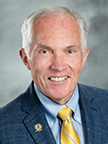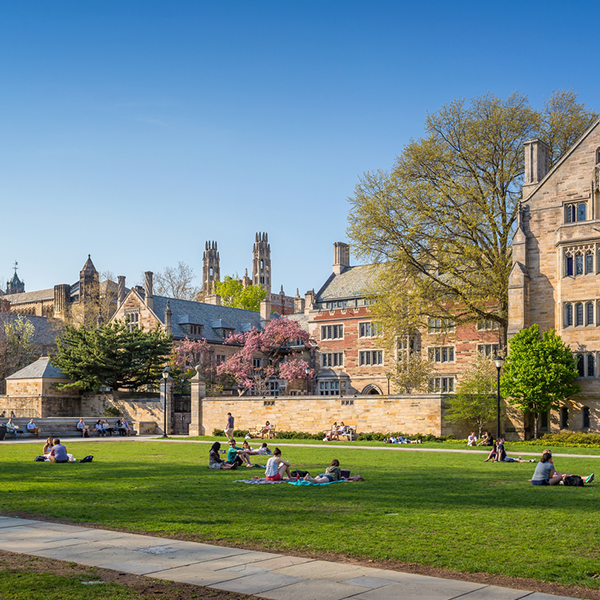Abstract
This case example illustrates key opportunities, processes, and outcomes of nearly a decade of intentional efforts to build and support community-engaged faculty culture and institutionalization in the School of Health and Human Sciences at The University of North Carolina at Greensboro (UNC Greensboro). Situated within a university-wide, faculty-led movement to institutionalize support for community engagement in the school through policy and practice, the authors describe the motivation of faculty and administrative leadership to integrate support for community engagement across teaching, research, and service roles in the health and human sciences unit at UNC Greensboro. The authors present critical moments of opportunity that were leveraged by faculty and administrative leadership to integrate community engagement into visioning and planning documents, faculty rewards and awards, curricular programming, and transdisciplinary scholarly work through community-engaged partnerships. Using information collected through faculty focus groups and document analysis, and as part of a multi-institutional research program sponsored by the American Association of State Colleges and Universities and the New England Resource Center for Higher Education, the authors describe key outcomes of efforts to institutionalize community engagement at the school level and highlight areas in which community engagement has been integrated into the school’s strategic plan. Of special importance are areas related to tenure and non-tenure-track faculty recruitment, faculty promotion and tenure policies, faculty grants and awards programs, and school-level strategic planning. The authors also describe various decisions regarding where to locate specific activities, efforts, and resources, whether at the department, school, or university-wide level.
Author Note
Emily M. Janke, The University of North Carolina Greensboro; Joi W. Bulls, The University of North Carolina at Greensboro; Dave H. Demo, The University of North Carolina at Greensboro; Celia R. Hooper, The University of North Carolina at Greensboro; Jeremy A. Rinker, The University of North Carolina at Greensboro.
Correspondence regarding this article should be addressed to Emily M. Janke, The University of North Carolina at Greensboro. E-mail: emjanke@uncg.edu

Describing how and why the School of Health and Human Sciences (HHS) at The University of North Carolina at Greensboro (UNC Greensboro) has become a national leader in supporting community engagement at the school level is like trying to describe a river—constantly flowing, dynamic, and ever-adapting to various internal and external forces. How does one describe the headwaters, the place where the river starts, before confluences emerge via tributary streams, groundwater runoff, or rain? What characteristics of the water does one describe—the water’s color and translucence, its chemistry, the way it reflects in the sunlight or ripples when the wind blows? Or does one describe the life within it, the biodiversity, individual organisms, or the webs of life? Then there are the endogenous life forms, creatures that have remained a feature of the river for an entire lifetime and those that have come and gone at different points, each leaving an indelible impression on the total ecosystem.
The challenge of describing any ecosystem, whether a river or a school within a university, is that there are many elements that have contributed to its character and vibrancy, and pointing to some elements will necessarily leave out others. This article presents the many elements that have shaped the development of a community-engaged school, from the perspective of a team of faculty and administrators who are diverse in their roles, experiences, and efforts to institutionalize community engagement within and across HHS. The co-authors provide different perspectives on HHS’s emergence as a community-engaged school: an administrator of a university-wide institute for community engagement, tenure- and non-tenure-track faculty, a long-term dean, and the current interim dean. We hope our articulation of developing a community-engaged school will be useful to other schools and institutions, particularly those that may be developing new strategic plans or who wish to fully review their structures and processes to support community engagement. Our experience suggests that there are institutional transitions that can lead to more meaningful transformations in not only policies, but also practice and faculty culture. To that end, we share key moments and movements that occurred within HHS as well as within UNC Greensboro more broadly.
The School of Health and Human Sciences is one of six schools and colleges within UNC Greensboro, an urban metropolitan campus located within the center of the state and enrolling more than 20,000 undergraduate and graduate students. Two thirds of the 790 full-time faculty are tenured or tenure-track. The university is one of approximately 50 that have been classified by the Carnegie Foundation for the Advancement of Teaching as both a “doctoral university with higher-research activity” (sometimes referred to as “R2”) and a “community engagement” institution. Established in 1891 as a university for women called the State Normal and Industrial School, the university went through several name changes (i.e., State Normal and Industrial College, North Carolina College for Women, Woman’s College of the University of North Carolina) and became one of the first three institutions of higher education to make up what is today known as the 16-campus University of North Carolina System (along with UNC-Chapel Hill and North Carolina State University), admitted students of color in 1956, and admitted men in 1964. Today, it is a minority-serving institution with half of its students identifying as ethnic minorities. It is the most diverse of the UNC system’s campuses. Throughout its entire history, the single word “service” has remained the university’s motto.
Confluences: Key Moments Toward Engagement
The headwaters of the School of Health and Human Sciences were formed in 2009, when HHS became the newest school on campus as the result of strategic restructuring of two schools that were ultimately closed. In the restructuring, many (but not all) departments of the two previous schools were brought together. This realignment necessitated the development of new leadership, new plans and policies, and a new faculty culture for the new school. In this way, the reorganization provided a transitional moment of opportunity that allowed many community-engaged faculty and administrators, in various ways, to articulate and integrate support for community-engaged teaching and scholarship throughout the school, and in school-level policies and practices. While the individuals who acted as change agents were critical to the development of community engagement, it is important to recognize the momentum that had already been generated at the university level for community engagement and that was carried into the development of HHS. The university context helped provide important motivation for faculty efforts to build HHS as an engaged school. In the following sections, we briefly describe key activities and initiatives that motivated and supported community engagement.
University Strategic Planning Process
In 2009, when HHS was coming into being, the campus community was engaged in a deeply participatory and expansive effort to write a strategic plan for the university. During this time, a number of faculty champions from within departments that would ultimately comprise HHS, as well as others, were involved in integrating community engagement into the plan. One indicator of this work was the university’s revised mission statement: “The University of North Carolina at Greensboro will redefine the public research university for the 21st century as an inclusive, collaborative, and responsive institution making a difference in the lives of students and the communities it serves” (UNC Greensboro, 2019). Faculty discussions focused on the importance of addressing the public purpose and mission of UNC Greensboro through a variety of activities, including but not limited to research, creative activities, and teaching.
Beyond the mission, support for community-engaged scholarship (CES) was a stated goal of the strategic plan: “UNCG will promote an inclusive culture of engaged scholarship, civic responsibility, and community service” (UNC Greensboro, 2012, Goal 4.3). The plan described the expectation that UNC Greensboro become a leader in engaged scholarship and local community service, and described different metrics, including establishing a common language operationalizing the terms engaged scholarship, civic engagement, and community service. It also called for the collaborative creation of an initiative to increase faculty understanding of and leadership and capacity for engaged scholarship, civic engagement, and community service. Importantly, the plan established the goal that CES would be recognized in promotion and tenure policies and practices “as a legitimate form of scholarship.”
Community-Engaged Scholarship Advanced in and by the Office of Research
The new school also benefited from increased institutional support offered by the Office of Research and Economic Development. In 2010, the vice chancellor for research and economic development (which was renamed as the Office of Research and Engagement in 2017) established the new position of special assistant for community engagement. This new position was established as an outcome of Goal 4.3 of the university strategic plan for the purpose of: (1) developing infrastructure to provide the resources, programs, processes, and support needed to achieve excellent and integrated community engagement across UNC Greensboro and beyond; and (2) creating a systematic, university-wide data collection strategy and website to improve communication about the various ways the university and community colleagues are connected (UNC Greensboro, 2012).
The HHS dean and several HHS faculty served on an advisory committee established by the special assistant in 2011 to help develop a strategic plan for supporting CES. The committee included 30 faculty, staff, administrators, students, and community partners. Over the course of a year, the dean and others participated in eight meetings, including a daylong, off-campus retreat that addressed key questions, including: What are the key indicators of excellence in community-university engagement, and what goals should UNC Greensboro and its community partners set for achieving excellence in community engagement in the next five years? As a result of participating in the strategic planning process for excellence in community engagement at the institutional level, the dean and several HHS faculty became increasingly involved in goal setting to support community engagement across the school and became more knowledgeable of the issues that can interfere with community engagement.
National Speaker Series
Many HHS faculty and administrators were invited to attend talks and meetings with national community engagement scholars to learn more about how to recognize and reward community-engaged scholarship in promotion and tenure policies (Amy Driscoll), community-engaged teaching (Patti Clayton), community-engaged departments (John Saltmarsh), and the value of community engagement for student learning and as an institutional strategy (George Mehaffy). These speakers were brought to campus through a joint effort of the special assistant for community engagement, the provost, vice chancellor for research, and chair of the faculty senate, as well as the directors of the office of leadership and service-learning, the teaching and learning center, and the undergraduate research office (see Janke & Clayton, 2012). Bringing together diverse sponsors in planning meetings helped to establish the interconnection of community engagement to various institutional priorities and to maintain buy-in from key institutional leaders.
In 2013, the chancellor and provost supported the decision of the vice chancellor for research to name the special assistant for community engagement as the founding director of the Institute for Community and Economic Engagement and associate professor of Peace and Conflict Studies, a department housed in HHS. Hence, faculty and administrative leadership in HHS received timely support and expert consultation through their participation in many working groups, committees, advisory boards, and guest speaker talks and workshops.
University Discussions About Promotion and Tenure Policies
Concurrent with conversations about university strategic planning, a core group of faculty had been advocating for the recognition of community engagement in promotion and tenure guidelines. After a year of discussions by the faculty senate committee and in various faculty forums, the faculty voted in spring 2010 to include recognition of community-engaged teaching, community-engaged research and creative activity, and community-engaged service in the promotion and tenure guidelines. Faculty from all schools, including HHS, served on the ad hoc committee and later on school/college and department committees to align policies with the university policy recognizing CES across faculty roles. For further discussion of UNC Greensboro’s process to support promotion and tenure guideline changes, and themes revealed as a result of a weeklong dialogue initiative with over 100 faculty and administrative leaders, see Janke, Holland, and Medlin (2016).
Building a Community-Engaged School
In this section, we describe key moments of opportunity and processes that were leveraged to intentionally integrate support for community engagement into HHS policy, practice, and culture. We describe how the opportunity to establish a new school was supported by timely and targeted professional development provided by a university-level office that supports the institutionalization of community engagement.
Grassroots Faculty Engagement in HHS
Undoubtedly, activity and advocacy for community engagement by community-engaged scholars at the university level helped generate policies and practices that could be further refined and developed as HHS established its own plan, policies, and practices. The new school included a number of faculty who identified as community-engaged scholars and who had worked in various ways to support the institutionalization of community engagement. Some of these faculty helped establish the service-learning office nearly a decade earlier, while others had advocated for community-engaged scholarship as chairs and members of department- and school-level promotion and tenure committees. Still others held faculty and administrative leadership roles in the university strategic planning process, as well as the university-wide promotion and tenure committee that successfully introduced CES into university promotion and tenure guidelines in 2010. Finally, other faculty, particularly in public health education, nutrition, human development and family studies, social work, community and therapeutic recreation, and peace and conflict studies, were active scholars teaching service-learning courses and conducting community-based research projects that included undergraduate and graduate students. In this way, the new school was filled with faculty, including department chairs, who were already committed to doing and advocating for CES. These faculty recognized and created opportunities to support the growth of CES in the development of the new school.
Engagement Academy for University Leaders
During the summer of the university-wide community engagement advisory committee’s work, the HHS dean was invited to attend a three-day Engagement Academy for University Leaders in Roanoke, Virginia. She, along with the special assistant for community engagement, the associate vice chancellor for student affairs, and the associate vice chancellor for economic development, were selected by the provost and vice chancellor for research and economic development to attend the meeting.
Acceptance into the Engagement Academy required that teams of administrators work before, during, and after the summer meeting to assess the level of institutionalization of community engagement at the university, and to develop an improvement plan for any identified areas. In the months leading up to the meeting, the provost, the vice chancellor for research and economic development, and the four attendees completed readings assigned by the Engagement Academy leaders (Drs. Lorilee Sandmann and Barbara Holland) and completed the Holland (1997) matrix of institutionalization of community engagement. In its assessment of institutionalization across UNC Greensboro broadly, the team identified HHS as a unit where ideas for community engagement could be integrated into policies and practices. It was determined that the Academy would be useful for the dean and the school since they were developing a number of plans and policies.
Ultimately, the Academy led to the development of a plan to advance community engagement within the new School of Health and Human Sciences, which opened July 1, 2011. The near-term goal of the plan was for HHS to adopt policies and practices that would serve as a model for a comprehensive, integrated, and cross-unit collaboration to support and sustain community engagement as it relates to faculty scholarship, student learning and development, and community impact. The longer-term goal was to “change the culture at UNCG such that community engagement is a valued, legitimate, and celebrated form of faculty scholarship and student learning” (UNC Greensboro, 2011).
Key strategic areas identified by the team at the Engagement Academy—which were ultimately adopted by the faculty in the HHS strategic plan—included: the establishment of an annual community engagement award for faculty; the appointment of a faculty member as part-time director of the HHS Office of Community-Engaged Scholarship; purposeful inclusion of community representatives on the HHS Board of Visitors, as well as intentional focus on community engagement as a recurring theme presented by the faculty and through student work showcased at each meeting; and the inclusion of the term community engagement throughout communications and marketing materials, including websites, pamphlets, the strategic plan, and coffee mugs distributed to faculty and staff.
Opportunity to Establish New School and Department Governance Policies
During the inaugural year of HHS, a faculty governance committee was tasked with developing promotion and tenure policies for the new unit, and a separate committee of faculty, department chairs, and associate deans was appointed to develop the first three-year HHS strategic plan. The dean’s office encouraged departments to create their own department-level promotion and tenure policies because many did not have them since they had used their previous school’s policy. Department chairs and faculty agreed largely that having departmental guidelines and examples would benefit faculty to clarify what scholarship looks like in their respective disciplines and contexts.
Taking Stock: Progress Toward Institutionalization Goals
In 2016, HHS was invited to participate in a pilot study to examine what institutionalization of community engagement looks like at the unit level. This provided an opportunity for the unit to take stock of its efforts to institutionalize and build a culture supportive of community engagement. The study was led by John Saltmarsh and Michael Middleton and was sponsored by the American Association of State Colleges and Universities and the New England Resource Center for Higher Education.
The HHS self-study was conducted by a small working group of faculty and administrators at the request of the HHS dean. The working group included two faculty members (one academic professional track (APT) associate professor, who was a full-time, non-tenure-track faculty member, and one tenure-track assistant professor), two associate deans (Research and Academic Administration), and the director of the Institute for Community and Economic Engagement (who previously served as the special assistant for community engagement, and who was also a tenured associate professor in Peace and Conflict Studies within the unit).
The self-assessment rubric provided to pilot study participants contains eight dimensions, each of which includes a set of components that characterize the dimension. Within each component were three possible “stages” of development, from “emerging” (Stage 1) to “developing” (Stage 2) to “transforming” (Stage 3; see the college engagement pilot rubric included in this special issue).
To determine which stage best characterized HHS for each component, committee members provided evidence of programs, policies, and activities. Working group members using existing data, such as school policy and program documents, completed many of the components of the rubric. However, other questions required additional information and input from faculty, which were collected through focus groups. The working group also met with department chairs all together to gain their perspectives on the school’s progress within component areas. Finally, the working group met with the HHS Research Advisory Committee and three focus groups of HHS faculty to solicit their views on the ways community-engaged work is valued and supported and ways to improve the recognition and support of this work. The intention was to ensure a comprehensive and representative view of the extent to which HHS has integrated support for community engagement across its policies and practices.
Findings
Participation in the self-assessment study was useful as it provided a systematic way to examine the school’s progress toward its goals to integrate support for community engagement across the unit. It also provided an opportunity to gather faculty and administrative leadership together in focus groups to discuss their experiences and perceptions of support for community engagement. The following section details evidence of transformation for the purpose of illustrating how one unit that has been effectively “transformed” by community engagement. We also share key insights learned about the importance of these institutional components residing at the school level specifically.
Leadership and Direction
A primary feature of institutionalized community engagement in a college is long-term, sustained, consistent, and committed leadership at the administrative level, among the dean, associate deans, and department chairs. It is important for academic deans to support community engagement since they lead strategic planning and resource allocation; they are also the final evaluators at the unit level for faculty hiring, reappointment, promotion, and, tenure. Deans provide unit leadership, support department chairs, and can inspire faculty, staff, and students about the value of community engagement and help instill a culture in an academic unit. For example, the HHS dean brought in outside speakers to help faculty implement best practices in community-engaged scholarship at the same time it was being included in promotion and tenure documents. She also highlighted research by faculty in school newsletters and presentations to the HHS Board of Visitors and even had it printed on HHS-branded giveaway mugs. At many university-wide events with donors, alumni, and other administrators, the HHS dean was careful to discuss community engagement as a hallmark of “the new school.” The message was clear: Community engagement was special and positive. If activities are valued at the top by a trusted administrator and supported by actions as well as words, they often find their way into the life of a school.
We further illustrate the success of these efforts in the following sections, demonstrating that community engagement is enacted through all forms of faculty work. These include the enactment of community engagement through: funded and unfunded research; integration into courses for students and professional development programs for faculty, students, staff, and community partners; partnerships initiated by groups and organizations that are external to the university and by teams of faculty and staff from that are inter-, multi-, and trans-disciplinary; and the words and actions of department chairs, associate deans, and deans who, along with faculty and staff, shape policies and culture to make community engagement a valued, legitimate, and supported way of serving institutional priorities.
Mission and Vision
Using the assessment tool, the team determined that the HHS mission and vision statements are aligned with community engagement, as described in the HHS strategic plan. In October 2011, Dean Hooper established a committee to create a strategic plan for the realigned school. The committee, comprising experienced faculty members, department chairs, and associate deans representing the school’s nine departments and programs, was charged with creating vision, mission, and values statements, and developing primary goals and strategies. The integration of community engagement into the school’s vision, mission, and values statements adopted for the 2012 plan continue to serve the school in 2019:
Vision Statement:
The School of HHS aims to inspire and equip people and transform institutions to work in ways that make the world better, safer, healthier, and more humane and just.
Mission Statement:
The School of HHS, through teaching, scholarship, community engagement and service, prepares new generations of professionals, leaders, scholars, and entrepreneurs to enhance the quality of life of individuals, families, and communities.
Values Statement:
As a community of scholars, the School of HHS values:
-
- Improved health, well-being, and quality of life for populations, communities, and individuals worldwide
- Care and respect for communities, with a focus on sustainability
- An academic environment in which diversity, inclusiveness, and respect for all is encouraged and celebrated
- Equitable partnerships when engaging with individuals, communities, and institutions in service and research
- Ethical principles applied to teaching, research, and community engagement
- A dynamic intellectual community that embraces interdisciplinary collaboration, creativity of thought, and innovativeness of practice (HHS, 2019).
Further, the initial 2012 plan expressed support for community engagement as a goal: “Support and expand community partnerships and scholarship within and beyond the university that transform the health, development, inclusion, and quality of life of all citizens, especially those from underserved, diverse, and vulnerable populations” (Personal communication, 2012). According to the plan’s stated objectives, HHS would (1) maintain and enhance community partnerships and outreach, and (2) support and expand collaborative, community-engaged scholarship that transforms the health, development, inclusion, and quality of life of all citizens.
Community Engagement as a Form of Multi-, Inter-, and Transdisciplinary Scholarship
Faculty shared that, for the most part, departmental colleagues now view community-engaged scholarship as just another form of scholarly work. Community engagement is viewed as an approach through which scholars and students address key societal and community-identified priorities, particularly as they are connected to health and wellness, vibrant communities, and global connections (key focus areas of the UNC Greensboro strategic plan). It has become ingrained in the culture of the school. In the words of one faculty member, “It is part of our surroundings, like air!”
In the 2015-2018 HHS strategic plan, community engagement was removed as a separate category and integrated intentionally as one approach among others needed for interprofessional, interdisciplinary, and experiential education, scholarship, and practice. The intention was to describe goals and activities that could include community engagement, while not excluding other forms of scholarly approaches. For example, within the goal of supporting faculty development, the plan included the following strategic activities:
- Support differential work assignments that optimize faculty productivity in teaching, research, service, and community engagement
- Provide opportunities for faculty to learn new research methods and approaches
- Allocate dollars to fund interdisciplinary teams to apply new methods to research
- Identify strategic hires that would enhance interdisciplinary collaborations and result in highly productive research teams
- Develop a database of faculty expertise in research and teaching methodologies (which lists community engagement)
- Link faculty members with community organizations in the North Carolina Piedmont Triad and beyond, including those affiliated with the HHS Board of Visitors
- At least two faculty “pitch” community engagement projects to the Board of Visitors each semester. (HHS, 2015)
Visibility and Communication
A primary feature of institutionalized community engagement in a school or college is the messaging that is created and shared about the work of the unit, what it values, how those values are put into practice, and how the scholarly identities of faculty and students are embodied in their activities. Expressions of support for community engagement are infused into communication materials and outlets developed for the new school. These include prominent messages and photos of CES and teaching on the school website, the HHS strategic plan pamphlet (distributed to faculty, alumni, donors and others), HHS publications and Board of Visitors presentations, and HHS-branded items (e.g., coffee mugs).
Community engagement is also featured in the faculty recruitment, selection, and hiring process. Because the individual departments comprising HHS are so diverse, there is no single HHS boilerplate description of community engagement that is included in all job descriptions. Instead, individual search committees prepare specific job descriptions, position announcements, and advertisements that describe the value and variety of community-engaged teaching and scholarship, and the opportunities and resources for new faculty to do this work. Anecdotally, candidates whom we have recently hired, as well as others we interviewed, have commented that they view efforts to support community engagement as attractive aspects of being a faculty member at UNC Greensboro. These efforts also provide a competitive advantage for UNC Greensboro when recruiting and hiring faculty.
The job descriptions posted by a number of departments express interest in faculty who will pursue community-engaged research agendas. For example, the Department of Peace and Conflict Studies includes the following in their job posting for a tenure-track assistant professor:
A successful candidate must be willing to lead the development and growth of initiatives that enact the mission of the department to help address the “wicked problems” of our times which require not only interdisciplinary theory and practice, or praxis, but also a deep understanding of the role of conflict in effecting and sustaining healthy relationships and vibrant communities. These initiatives are expected to leverage synergies among teaching, scholarship, and community engagement. (Personal communication, 2017)
Community engagement is expressed as an approach through which inter- and transdisciplinary scholarship can be executed so that theory is applied to practice and practice is applied to theory (i.e., praxis). The expressed value of CES is reiterated during on-campus interviews as several departments require candidates to meet with the director of the Institute for Community and Economic Engagement. The intention is to signal to potential candidates the opportunities for, and importance of, CES as a legitimate and valued form of scholarship, and to gauge candidates’ understanding of and expertise in this area.
Recognitions
A primary feature of institutionalized community-engaged scholarship in a college is making that scholarship visible and celebrating its success in public ways. The importance of community engagement is represented in annual faculty reporting, asking about community engagement activities in the document. Additionally, the dean established an annual HHS Community Engaged Scholarship Award, which recognizes and rewards (with $1,000) a member of the HHS faculty who demonstrates excellence in scholarly engagement with a community partner. The award requires that community engagement benefit the university and a community partner, while demonstrating a clear connection to departmental, school, or university mission. This award is given annually at the year-end HHS faculty symposium, alongside the presentation of other awards for excellence in teaching, research, and service.
Rewards
A primary feature of institutionalized community-engaged scholarship in a school is that it is valued through formal reward structures, with explicit policies and criteria, valuing CES in the core academic culture of the unit. Recognition for community-engaged research, community-engaged teaching, and community-engaged service are explicitly recognized in the HHS promotion and tenure policy for tenure-track faculty, mirroring the university-wide policy adopted in 2010. Further, the HHS policy begins with a statement on the “Centrality of Scholarship in Faculty Roles and Responsibilities,” which states that scholarship is characterized by original intellectual work that results in the creation, synthesis, dissemination, and/or application of knowledge. It is based on a high level of professional expertise, and its significance can be validated by peers.
Avenues of scholarship include research, creative works and community engagement. Within each of these avenues, scholarship can be achieved by a variety of methods, in a variety of contexts, and in pursuit of a variety of purposes; it can enhance or revise disciplinary knowledge, have an impact on various populations or organizations, or offer new theoretical insights. Because of the breadth of scholarly activity and its conduct, the path of any scholarly agenda will vary according to the nature of its questions and the means of their pursuit” (emphasis added to indicate explicit support for community- engaged scholarship; HHS, 2015, pp. 2-3).
Since 2012, all departments have either developed their own policies that integrate community-engagement or have chosen to use the HHS policy. It is important to note that recognition for community-engaged teaching is also articulated in the academic professional track faculty reappointment and promotion policies.
Approximately one third of faculty teaching in HHS are APT faculty. Most APT faculty have multi-year contracts, and some have worked at the university for decades. Typically, APT faculty have primary responsibility for teaching and advising students, although many also supervise, direct, or administer a program. As stated in the Promotion and Evaluation Policy for APT faculty, “most of these assignments are carried out in connection with the professional preparation of students in all of the disciplines represented in HHS where application of theory to practice is an integral ingredient of the curriculum” (HHS, 2019, p.1). As such, many APT faculty have participated by supervising community-focused internships and service-learning courses.
While an APT position is non-tenure-track, it allows for promotion from instructor to assistant to associate to full professor ranks, through a promotion process similar to that for tenure-track faculty. Therefore, APT faculty may be rewarded for participating in community engagement efforts through their service, scholarship, and/or teaching. In 2012, the APT faculty governance body reviewed its policy and included explicit support for community-engaged teaching. Found in The Academic Professional Track: Policies, Guidelines, and Procedures, the policy stated:
Participating in Community Engaged Teaching: Developing and delivering community-based instruction, such as service-learning experiences, on-site courses, clinical experiences, professional internships, and collaborative programs; developing and delivering off-campus teaching activities such as study-abroad courses and experiences, international instruction, and distance education courses; and developing and delivering instruction to communities and other constituencies. (HHS, 2019, p. 4)
Recognition for community-engaged teaching is particularly important as APT faculty supervise many internship and practicum programs that occur through community partnerships. The purpose of the APT was to have some consistency for departments that rely on non-tenure-track faculty, providing stability for the faculty and the department. The expectations are different from tenure-track faculty in that their roles vary depending on the expectations of the department. APT faculty make valuable contributions in a variety of areas depending on the expectations set forth. APT faculty may focus on administering a program. For example, in Human Development and Family Studies, there are five APT faculty, but each has different roles. Two of the faculty direct and supervise students during the professional experience (i.e., internship and student teaching), while another faculty member directs the childcare facility on campus. Typically, APT faculty have a heavy teaching schedule, but some are unable to teach or have limited teaching due to their responsibilities. Furthermore, APT faculty may also participate in traditional and nontraditional scholarship. However, the APT faculty do not carry the weight of “publish or perish,” which is expected of tenure-track faculty. Additionally, many APT faculty have received local, regional, and national recognition in their respective fields.
Capacity-Building Infrastructure for Support and Sustainability
A primary feature of institutionalized community engaged scholarship in a college is the establishment of a capacity-building infrastructure that supports and sustains CES. During the initial launch of HHS, the dean appointed Bob Wineburg, the Jefferson Pilot Excellence Professor, as HHS Director of Community Engagement. Wineburg’s first charge was to obtain a data-driven picture of HHS engagement using a community engagement survey. The survey, which yielded an astounding 83% response rate, revealed what engagement looks like in terms of duration, faculty status, outcomes, challenges, and needs. Analysis of the results showed that HHS faculty, on average, have four organizational affiliations through which they conduct collaborative research with partners, work with students on organizationally based research projects and other student assignments, guide organizations in governance, such as serving as a board member, and/or participate in advocacy roles that promote and enhance the work of their partner agencies. An important finding of this study was the demonstration of HHS faculty engagement with external and local communities through a variety of faculty and scholarly roles.
Importantly, the study showed that community engagement is relevant to nearly all faculty, not just those who identify as community-engaged scholars. This finding motivated later efforts within HHS and the Institute for Community and Economic Engagement to track community-university partnerships more comprehensively across the university in the databases they developed and maintain. These databases are used to help connect and convene faculty members for teaching and research activities that address community-identified priorities through a community-engaged approach.
The director position lasted only several years as the dean’s office worked to integrate support for and recognition of community-engaged scholarship into associated deans’ offices, most notably the HHS Office of Research. The school has intentionally focused on fostering and rewarding multi-, inter-, and transdisciplinary teaching and research. For example, the HHS Office of Research encourages scholarship across and beyond disciplinary boundaries through its funding, tracking, and professional development efforts. The office provides internal funding mechanisms and strategically offers higher funding amounts for research projects that involve faculty from more than one discipline. It developed a database to track faculty members’ areas of scholarly activity and research methods/approaches for the purpose of helping to identify and convene potential collaborators for various funded and non-funded research opportunities. Community-engaged scholarship is one strategy among others identified in the database. The office also provides professional development workshops and speakers on topics that encourage community-engaged as well as multi, inter-, and transdisciplinary scholarship. Concurrent with the closing of the HHS Community Engagement Office, the Institute for Community and Economic Engagement was established in the Office of Research and Economic Development (now the Office of Research and Engagement) as a way to support CES across the campus. The HHS associate dean for research regularly posts additional opportunities offered by the Institute for Community and Economic Engagement to the school-wide listserv.
Assessment
The systematic collection and evaluation of data to better understand the extent, quality, and impact of community engagement activities—what might be termed the institutionalized community-engaged scholarship in a school or college—has become a routine aspect of HHS culture. As described earlier, the HHS director of community engagement initially developed a survey as a way to understand the number and scope of community connections and partnerships HHS faculty had developed. In 2013, the Institute for Community and Economic Engagement led a university-wide process of tracking UNC Greensboro’s connections to and collaborations with external communities by embedding into existing systems—and, where necessary, creating new systems to measure and assess the broad range of community-engaged activities, programs, and initiatives. The purpose of this centralized effort is to track improvements in programs, curricula, and partnerships. In an effort to do a better job of communicating community engagement stories and, where appropriate, connecting faculty, staff, and community partners around shared community-identified priorities and passions, UNC Greensboro designed the Collaboratory®, a publicly searchable, web-based database that was licensed to TreeTop Commons in 2013. Collaboratory helps the university, including HHS, understand who, what, where, and how faculty, staff, students and community partners are working together to align strengths with priorities for shared learning and mutual benefit. Thus, tracking community engagement became the responsibility of the centralized Office of Research and Engagement, rather than individual units.
Curricular Pathways
Critical to the institutionalization of community engagement in a school like HHS are processes for developing clear curricular pathways so that all students have the opportunity to learn about and practice community engagement and master clearly articulated civic-learning outcomes. Integrating community engagement in curricular structures and pathways, although an ongoing process, was emphasized even before the creation of HHS in 2009. Initially devised and taught by a social work professor, HHS now offers a unit-level graduate course entitled Professional Grant Writing for Health and Human Service Organizations in the Community. This course was initially co-taught with a community partner and provided a model for both external and internal university partnerships. Now a collaborative unit-level course aimed at teaching grant-writing skills and developing joint funding opportunities with community partners, this course has been widely subscribed by students in public health education and social work, and has not only strengthened community-university partnerships, but also conveyed critical skills in doing community work to HHS students. Taught with a community-engaged lens, this course exemplifies unit-level commitment to CES.
At the department level, many departments in HHS have shown their commitment to community engagement by integrating field work and community-engaged practica into their undergraduate and graduate capstone courses. Peace and Conflict Studies, for example, has developed their PCS 690: Integrative Colloquium course as a means for students to apply the theories they have learned in developing praxis toward conflict transformation in local community settings. Social Work, Human Development and Family Studies, Public Health Education and Community and Therapeutic Recreation have also all integrated community engagement experiences into their capstone internship and field research courses. These department-level courses help develop a reciprocal relationship with the outside community and support the HHS until-level course mentioned previously.
These examples of developing curricular pathways for community engagement represent an important vector for developing unit-wide acceptance of community-engaged scholarship. HHS’s commitment to the development of HHS-prefix, or school-wide, courses has allowed faculty to develop curriculum that is not “owned” by any one department and could be used to reinforce the importance of scholarship that impacts the community rather than simply studying it. Clear community-engaged curriculum models partnership with community partners and teaches students and faculty the value of collaborative relationships. At the unit level, HHS is certainly moving into the transforming category of community-engaged curriculum. Although more remains to be done to strengthen community engaged curricular pathways, much has already been accomplished.
Conclusion
Our case example of the School of Health and Human Sciences at the University of North Carolina at Greensboro illustrates some of the key opportunities, processes, and outcomes of nearly a decade of intentional efforts to build and support community-engaged faculty culture and institutionalization. It is an example of the ways larger university initiatives, such as strategic planning, can help create a sense of momentum for community engagement that can be actualized within a school, as well as through the creation of offices and staff housed centrally in a research office. It is an example of opportunism, how an opportunity to develop new policies and a school identity can be harnessed to contribute to the growth of support for community engagement. It is an example of elevating, recognizing, and rewarding the important contributions of non-tenure-track faculty as community-engaged scholars. Finally, it is an example of the importance of engaging all levels of leadership—where the grassroots movement and executive leadership are joined together by key champions and change agents who enact the policies and programs to develop new paths and norms for engagement.
The opportunity to revisit progress through involvement in a self-study demonstrated that efforts to continue to support and encourage community engagement must continue. As HHS has arguably become a leader in community engagement within the university in terms of the ways support has been institutionalized and adopted as part of the school’s culture, it is important to foster conversation and transformation across other units. The self-study also raised important questions and insights about what kinds of support should be provided by the school, and what might be more usefully integrated into the structures and efforts of a central, university-wide office, such as the Institute for Community and Economic Engagement. Lastly, the process of the self-study revealed that new types of issues, concerns, and opportunities arise, even as cultures and systems are developed to support engagement. For example, HHS faculty are increasingly working collaboratively in large teams or consortia of faculty and community-based partners to address community-identified priorities through teaching and scholarship. Such large-scale initiatives of collective commitment are important; yet, they are quite different from the more individualistic faculty partnerships of the past regarding how they are supported. Ultimately, community engagement requires continued stewardship and self-study as the people and processes continue to evolve and transform.
References
Holland, B. A. (1997). Analyzing institutional commitment to service: A model of key organizational factors. Michigan Journal Community Service Learning, 4, 30-41.
Janke, E. M., & Clayton, P. H. (2012). Excellence in community engagement and community-engaged scholarship: Advancing the discourse at UNCG (Vol. 1). Greensboro, NC: University of North Carolina at Greensboro.
Janke, E. M., Holland, B. A., & Medlin, K. B. (2016). Intense, pervasive and shared faculty dialogue: Generating understanding and identifying “hotspots” in five days. Metropolitan Universities Journal, 27(2), 19-35.
University of North Carolina at Greensboro. (2012). UNCG 2009-2014 strategic plan. Retrieved from https://www.uncg.edu/inside-uncg/inside-history.php
University of North Carolina at Greensboro. (2019). The UNCG vision and mission. Retrieved from https://www.uncg.edu/inside-uncg/mission/
University of North Carolina at Greensboro, School of Health and Human Sciences. (2015). School of Health and Human Sciences promotion and tenure policies, guidelines, and procedures. Retrieved from https://hhs.uncg.edu/wp-content/uploads/sites/28/2019/08/
hhs-promotion-and-tenure-policies-guidelines-2015.pdf
University of North Carolina at Greensboro, School of Health and Human Sciences. (2018). School of HHS strategic plan 2018-19. Retrieved from https://hhs.uncg.edu/wp-content/uploads/sites/28/2019/07/HHS_strategic-plan-2018-19_final.pdf
University of North Carolina at Greensboro, School of Health and Human Sciences. (2019). The academic professional track: Policies, guidelines and procedures. Retrieved from https://hhs.uncg.edu/wp-content/uploads/sites/28/2019/08/HHS-Academic-Professional-Track-Document-05022019.pdf.
Authors
 Emily M. Janke, PhD, is an associate professor in the Peace and Conflict Studies department and director of the Institute for Community and Economic Engagement (ICEE) at the University of North Carolina at Greensboro. Emily’s teaching and scholarship explore multiple aspects of community engagement, including community-university relationships and partnerships, institutional culture and change strategies for higher education, and the role of reciprocity, communication, and tension in collaborative interdisciplinary and multi-sector relationships. As the director of ICEE, Emily leads initiatives that encourage, support, elevate, and amplify faculty, staff, student, and community colleague community-engaged teaching, learning, research, creative activity, and service in ways that promote the strategic goals of the university, address pressing issues in the Piedmont Triad, and serve the public good of communities across the state, nation, and world.
Emily M. Janke, PhD, is an associate professor in the Peace and Conflict Studies department and director of the Institute for Community and Economic Engagement (ICEE) at the University of North Carolina at Greensboro. Emily’s teaching and scholarship explore multiple aspects of community engagement, including community-university relationships and partnerships, institutional culture and change strategies for higher education, and the role of reciprocity, communication, and tension in collaborative interdisciplinary and multi-sector relationships. As the director of ICEE, Emily leads initiatives that encourage, support, elevate, and amplify faculty, staff, student, and community colleague community-engaged teaching, learning, research, creative activity, and service in ways that promote the strategic goals of the university, address pressing issues in the Piedmont Triad, and serve the public good of communities across the state, nation, and world.
 Joi W. Bulls, PhD, is associate chair and an academic professional associate professor in the Department of Human Development and Family Studies at the University of North Carolina at Greensboro. In this role, she has taught courses on partner and family relationships and professional development within HDFS. As associate chair, her primary role is to coordinate curriculum for the department. Dr. Bulls is also the internship director for HDFS. In this capacity, she supervises upper-level students as they complete internships in social services agencies locally, regionally, and nationally. She has her BS in Psychology from Tuskegee University, an MS in Counseling Psychology, and a PhD in Family Relations from The Florida State University.
Joi W. Bulls, PhD, is associate chair and an academic professional associate professor in the Department of Human Development and Family Studies at the University of North Carolina at Greensboro. In this role, she has taught courses on partner and family relationships and professional development within HDFS. As associate chair, her primary role is to coordinate curriculum for the department. Dr. Bulls is also the internship director for HDFS. In this capacity, she supervises upper-level students as they complete internships in social services agencies locally, regionally, and nationally. She has her BS in Psychology from Tuskegee University, an MS in Counseling Psychology, and a PhD in Family Relations from The Florida State University.
 David H. Demo, PhD, is associate dean for academic administration in the School of Health and Human Sciences and professor of human development and family studies at the University of North Carolina at Greensboro. One of his primary responsibilities as associate dean has been the development of interdisciplinary courses and programs. He served as editor of the Journal of Marriage and Family from 2007 to 2012. His research focuses on divorce and family transitions, changes in family relationships accompanying divorce, and the consequences of family transitions for family members’ well-being. His recent work examines the effectiveness of various advocacy methods for promoting faculty accomplishments, securing resources, and bolstering academic programs. He has published widely in professional journals and has authored or edited six books. He is a fellow of the National Council on Family Relations.
David H. Demo, PhD, is associate dean for academic administration in the School of Health and Human Sciences and professor of human development and family studies at the University of North Carolina at Greensboro. One of his primary responsibilities as associate dean has been the development of interdisciplinary courses and programs. He served as editor of the Journal of Marriage and Family from 2007 to 2012. His research focuses on divorce and family transitions, changes in family relationships accompanying divorce, and the consequences of family transitions for family members’ well-being. His recent work examines the effectiveness of various advocacy methods for promoting faculty accomplishments, securing resources, and bolstering academic programs. He has published widely in professional journals and has authored or edited six books. He is a fellow of the National Council on Family Relations.
 Celia R. Hooper, PhD, is professor and founding dean emerita of the University of North Carolina at Greensboro School of Health and Human Sciences and was previously a dean of a smaller unit at UNC Greensboro. She was past department head of the Department of Communication Sciences and Disorders at UNC Greensboro, faculty member at UNC Chapel Hill, the University of Kansas, and Case Western Reserve University. She is currently the interim dean of Health Sciences at Winston-Salem State University. Her research with adult neurogenic disorders, voice disorders, and transgender communication has been community-engaged and applied since 1979. She helped found the Evidence Based Practice Center of the American Speech Language Hearing Association (ASHA) and has received honors from ASHA for her contributions to the field of speech and hearing sciences as well as honors from the Association of Schools of Allied Health Professions. She is currently a national consultant, helping universities with restructuring to form schools of health and wellness, with a focus on community-engaged research.
Celia R. Hooper, PhD, is professor and founding dean emerita of the University of North Carolina at Greensboro School of Health and Human Sciences and was previously a dean of a smaller unit at UNC Greensboro. She was past department head of the Department of Communication Sciences and Disorders at UNC Greensboro, faculty member at UNC Chapel Hill, the University of Kansas, and Case Western Reserve University. She is currently the interim dean of Health Sciences at Winston-Salem State University. Her research with adult neurogenic disorders, voice disorders, and transgender communication has been community-engaged and applied since 1979. She helped found the Evidence Based Practice Center of the American Speech Language Hearing Association (ASHA) and has received honors from ASHA for her contributions to the field of speech and hearing sciences as well as honors from the Association of Schools of Allied Health Professions. She is currently a national consultant, helping universities with restructuring to form schools of health and wellness, with a focus on community-engaged research.
 Jeremy A. Rinker, PhD, is an assistant professor in the University of North Carolina at Greensboro’s Department of Peace and Conflict Studies, where he researches the intersections of narrative, violent conflict, and nonviolent conflict transformation. Jeremy’s research interests revolve around the centrality of justice discourse, trauma awareness, and collective resilience in institutions and movements aimed at transforming social injustices. Jeremy has received internal university funding to work with displaced refugee communities and at-risk youth in North Carolina, as well as external funding to study the collective historical trauma of post-colonial India as a Nehru-Fulbright grant awardee (2013-2014) and to support community partnerships with the city of Greensboro. Jeremy remains steadfastly committed to exploring the complex pedagogies of conflict praxis and ensuring that students have experiences that will challenge their perception about how to best assist communities in conflict.
Jeremy A. Rinker, PhD, is an assistant professor in the University of North Carolina at Greensboro’s Department of Peace and Conflict Studies, where he researches the intersections of narrative, violent conflict, and nonviolent conflict transformation. Jeremy’s research interests revolve around the centrality of justice discourse, trauma awareness, and collective resilience in institutions and movements aimed at transforming social injustices. Jeremy has received internal university funding to work with displaced refugee communities and at-risk youth in North Carolina, as well as external funding to study the collective historical trauma of post-colonial India as a Nehru-Fulbright grant awardee (2013-2014) and to support community partnerships with the city of Greensboro. Jeremy remains steadfastly committed to exploring the complex pedagogies of conflict praxis and ensuring that students have experiences that will challenge their perception about how to best assist communities in conflict.




